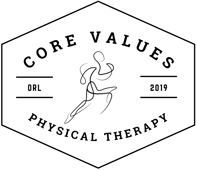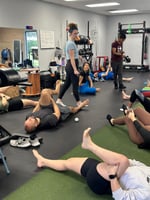Runners are especially susceptible to hamstring pain. This is due to the eccentric nature of slowing down the leg before your foot hits the ground while running.
Most often you have a strain at the musculotendinous junction: where the muscle attaches to the tendon that then attaches to the bone.
You can have a proximal hamstring tendinopathy (PHT): this is where there is a degeneration of the tendon at the site where it attaches to the butt bone called the ischial tuberosity.
You can also have a strain of the muscle belly itself. There are 3 muscles of the hamstring: The biceps femoris (most often associated with hamstring injuries), semimembranosus and semitendinosus.
So what does it feel like?
-
Typically PHT presents with pain well localized to the tendon origin at the ischial tuberosity
-
Early morning stiffness may be present (as is common in tendinopathy)
-
Latent pain is common, meaning you can feel fine during an activity but you can have a delayed increase in symptoms later on or even the next day.
-
Pain may be present at the start of activity and ‘warm up’ and settle in as the activity progresses. And then you may have latent pain.
PHT should not have wide-spread symptoms, numbness or tingling or have back pain associated with it. See more about this in the differential diagnosis section.
Aggravating and easing factors
-
Usually PHT is aggravated by sitting, stretching, lunging and deep squat positions, uphill running and faster running sessions (although if irritable even slow running on the flat can be sore)
-
This is because those positions and movements compress the tendon at the site of the ischial tuberosity or place too much load on the tissues.
-
Check out this IG on how to make sitting more comfortable for PHT
-
-
It’s usually more comfortable standing and walking (although can be sore with brisk walking or hill walking)
Things to ask yourself:
-
How long can I sit for?
-
What pace can I run at without having discomfort?
-
How long can I run before I get discomfort?
-
How fast can I walk?
-
Can I run flat without a problem but adding in sprints or hill work aggravates my symptoms?
I always like to note how Distance, Pace and Frequency change my pain so I can track and train my athletes accordingly.
Other issues that can present like PHT or hamstring strain, aka Differential Diagnosis:
-
Lumbar spine disorders can refer down into the buttock and posterior thigh when the nerves that exit out through there are irritated.
-
Hip: some hip disorders can also have a similar pain pattern
-
Piriformis: when tight or irritated it can compress the sciatic nerve, referring pain down the buttock and leg
-
Posterior hip impingement: when the hip doesn’t glide as it should and pinches.
Make sure you are being put through a very detailed examination to rule out other possible diagnoses so that you get accurate rehab.
So now you’re probably wondering why this happened or is happening to you.
Most injuries occur when too much load is applied to a specific tissue. Sometimes the load is too much, such as an increase in training volume, adding in more hills or more speed word. But sometimes your tissue tolerance can go down with stress, illness, fatigue, nutrition or hydration issues.
You really want to get in to see a medical provider as soon as possible so you have a chance to get better fast.
If this becomes a chronic condition you have to start looking at and as needed addressing running mechanics, muscles weaknesses and/or stiffnesses.
Stages of Hamstring Rehab
I want to emphasize that that every athlete is different and will progress through and respond differently to these stages. The rehab process can take roughly 6 months but can take longer in certain cases.
Stage 1
This is when the tendon is more acute and will respond well to isometrics in mid-range.
Typically we want 1 or 2 exercises done 4 or 5 times with 40-45 second holds (2 or 3 times per day).
For example: The hamstring Bridge: perform 40-45 seconds 4-5 times and can be done 2-3 times/day.
Progress to stage 2 when able to tolerate stage 1 exercises with minimal pain, roughly a 0-4 on a 0-10 pain scale with minimal to no reaction the following day. The exercises will need to be tested in a controlled setting to know exactly how you are going to react and if it is the right reaction. Many patients will need time working at stage 2 before symptoms will settle and tolerate more compressive positions.
Stage 2
Heavy Slow Resistance training (HSR) 3 to 4 times per week, typically starting at 15RM and progressing to around 8RM. We would ideally like to strengthen the hamstrings with 3 exercises involving minimal hip flexion, we work into more hip flexion in stage 3.
May include
– Double or single leg bridge
– Prone hamstring curl or a nordic curl
– Straight leg pull down or hip extension against pulley machine/ theraband
– Hamstring curls on a yoga ball
Can sprinkle in non-hamstring specific exercises to fully address the kinetic chain and give the hamstrings a chance to rest between exercises.
Stage 3
Progress to stage 3 when the exercises are tolerable with pain less than 3-4/10. Stage 3 is to increase the hip flexion position and start to bring the hamstring into a stretch and compress position. For example:
– Step ups
– Hip thrusts
– Shallow range deadlifts, progressing into range as tolerated then onto single leg
– Lunges
Again, mix these up with other exercises to address the whole kinetic chain and any other movement faults. We can also start to address running mechanics and a return to run plan during this stage.
Stage 4
Not all patients need to progress to this level and those who do need to progress slowly. This would be appropriate for sports and athletes who require agility and speed such as soccer players, sprinters and hurdlers.
We typically start by introducing 1 plyometric exercise within the session and see how symptoms respond. Then we will gradually add exercises as tolerated and progress the range of motion at the hip and hamstring as needed.
Stage 5
– plyometric exercise examples
– Ladder drills
– Bounding, progressing to hill bounding or straight leg bounding
– A skips and B skips
– Sport specific work like cutting and change of direction exercises
We can also start to play around with the speed at which you perform your HSR exercises.
Keep in mind that we aren’t done when we get here though, maintaining what has been achieved is vital in keeping yourself healthy. The tendon is very needy and pain is frequently recurrent when athletes stop their rehab or stop following their training plan. So keep up the good work and you should be all set!
If you have hamstring pain and want to get yourself fixed, set up a call with us today!
Thank you for reading!!!
Rebecca Smith, PT, DPT




